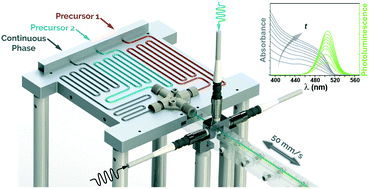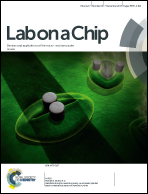Automated microfluidic platform for systematic studies of colloidal perovskite nanocrystals: towards continuous nano-manufacturing†
Abstract
Colloidal organic/inorganic metal-halide perovskite nanocrystals have recently emerged as a potential low-cost replacement for the semiconductor materials in commercial photovoltaics and light emitting diodes. However, unlike III–V and IV–VI semiconductor nanocrystals, studies of colloidal perovskite nanocrystals have yet to develop a fundamental and comprehensive understanding of nucleation and growth kinetics. Here, we introduce a modular and automated microfluidic platform for the systematic studies of room-temperature synthesized cesium–lead halide perovskite nanocrystals. With abundant data collection across the entirety of four orders of magnitude reaction time span, we comprehensively characterize nanocrystal growth within a modular microfluidic reactor. The developed high-throughput screening platform features a custom-designed three-port flow cell with translational capability for in situ spectral characterization of the in-flow synthesized perovskite nanocrystals along a tubular microreactor with an adjustable length, ranging from 3 cm to 196 cm. The translational flow cell allows for sampling of twenty unique residence times at a single equilibrated flow rate. The developed technique requires an average total liquid consumption of 20 μL per spectra and as little as 2 μL at the time of sampling. It may continuously sample up to 30 000 unique spectra per day in both single and multi-phase flow formats. Using the developed plug-and-play microfluidic platform, we study the growth of cesium lead trihalide perovskite nanocrystals through in situ monitoring of their absorption and emission band-gaps at residence times ranging from 100 ms to 17 min. The automated microfluidic platform enables a systematic study of the effect of mixing enhancement on the quality of the synthesized nanocrystals through a direct comparison between single- and multi-phase flow systems at similar reaction time scales. The improved mixing characteristics of the multi-phase flow format results in high-quality perovskite nanocrystals with kinetically tunable emission wavelength, ranging as much as 25 nm at equivalent residence times. Further application of this unique platform would allow rapid parameter optimization in the colloidal synthesis of a wide range of nanomaterials (e.g., metal or semiconductor), that is directly transferable to continuous manufacturing in a numbered-up platform with a similar characteristic length scale.

- This article is part of the themed collection: Lab on a Chip Emerging Investigators


 Please wait while we load your content...
Please wait while we load your content...